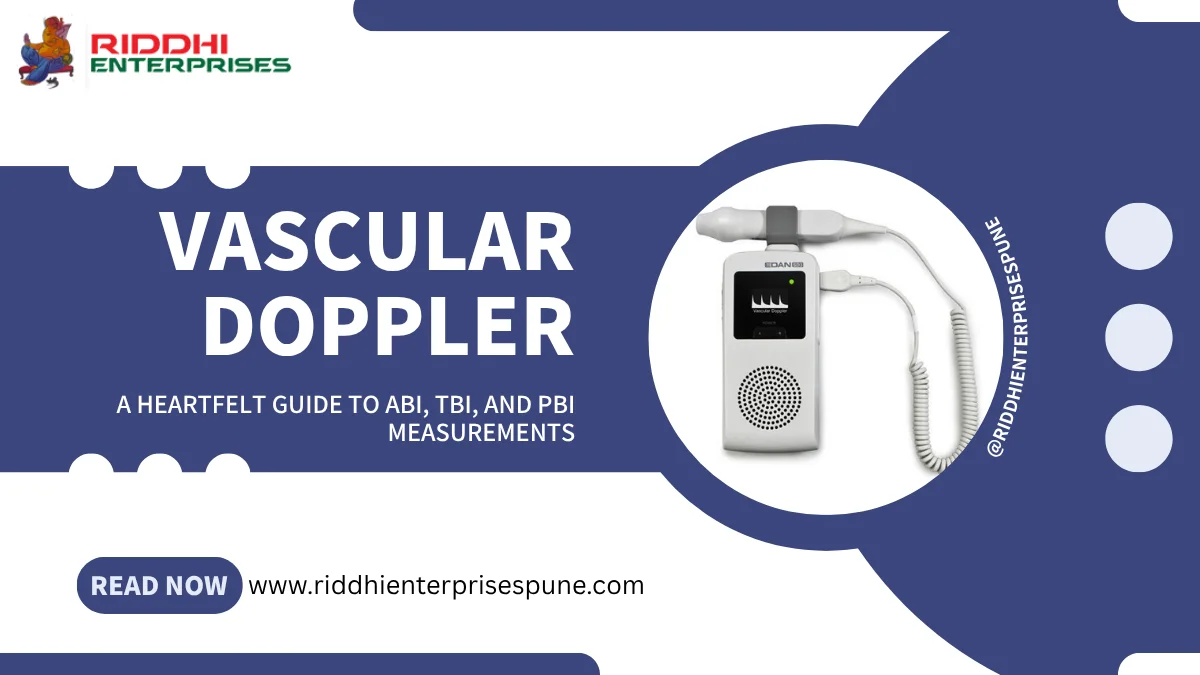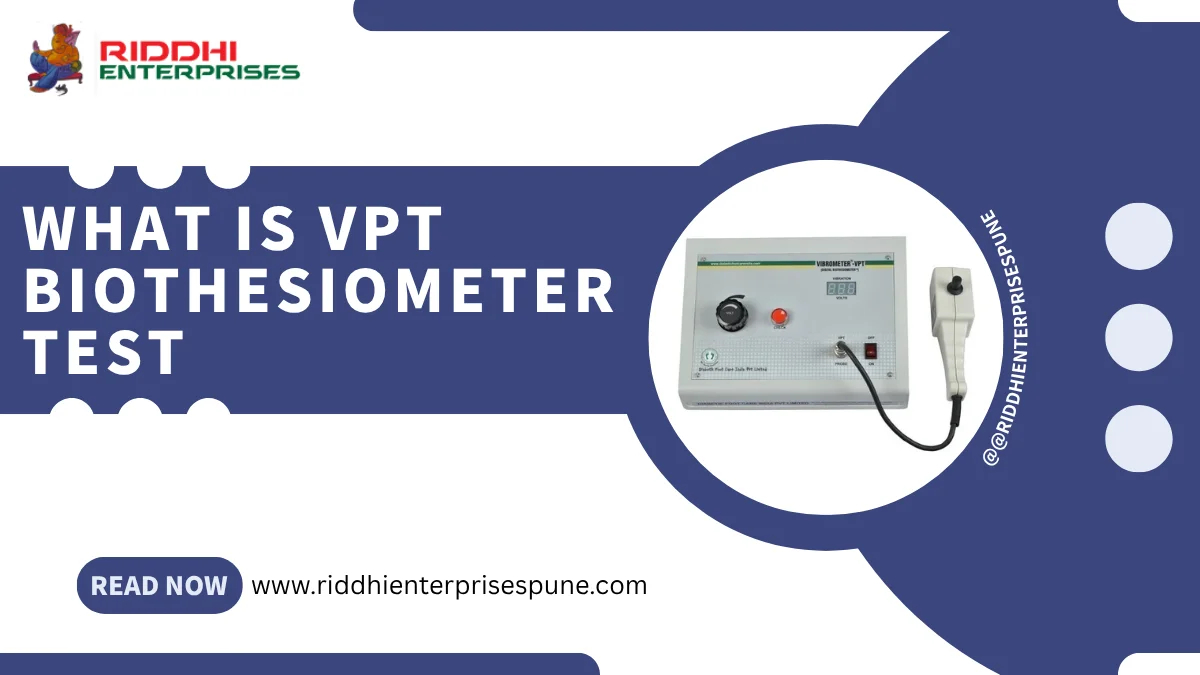-
Welcome To Riddhi Enterprises
-
Our Opening Hours Mon- Fri - 10AM - 6PM
Vascular Doppler Measurements Guide

Vascular Doppler Measurements Guide
Have you ever wondered how doctors peek into your blood vessels without a single poke? That’s where Vascular Doppler steps in. Picture this: a small wand gliding over your skin, sending out gentle sound waves that whisper back the story of your blood flow. In this friendly guide, we’ll walk you through the three superstar measurements, Ankle-Brachial Index (ABI), Toe-Brachial Index (TBI), and Popliteal-Brachial Index (PBI) so you feel confident reading your own reports or chatting with your vascular specialist.
Why Vascular Doppler Matters?
Not all chest pains or leg cramps signal trouble, but when arteries stiffen or narrow, tissues down the line starve for oxygen. That’s peripheral artery disease (PAD), and it affects millions worldwide. A quick Vascular Doppler check can reveal clogged pathways before you notice worrisome symptoms. Early detection means simpler treatments and better outcomes—no one wants leg ulcers or nasty infections when a noninvasive test does the job.
ABI: Your First Stop
ABI sounds fancy, but it’s a breeze. After you’ve rested on your back for a good ten minutes, a snug cuff goes around each ankle and your upper arm. A Doppler probe then captures the highest systolic pressures. Mathematically, you just divide ankle by arm ABI = ankle pressure ÷ brachial pressure.
- Normal folks land between 1.0 and 1.3.
- Got borderline vessels? You’ll see 0.91–0.99.
- Under 0.90? That’s a red flag for PAD.
There’s even a hidden twist: ABI above 1.40 often means your arteries are calcified, acting like concrete pipes. In such cases, ABI loses reliability but your doctor will know to move on to the next test.
TBI: The Toe Knows Best
In diabetes or advanced age, leg arteries can jackhammer your readings. That’s when the Toe-Brachial Index (TBI) shines. Clip a photoplethysmography sensor onto your big toe, measure its systolic pressure, and divide by your arm’s pressure. A healthy TBI sits north of 0.70; under that, PAD is likely hiding in plain sight. You won’t feel toe calcification nearly as much, so TBI rescues you when ABI misfires.
PBI: The Behind-the-Knee Hero
Sometimes, ankle wounds or swelling make cuff placement impossible. Enter the Popliteal-Brachial Index (PBI). The popliteal artery lies behind your knee, easy to tap with a Doppler probe. Like the others, PBI equals that pressure ratio popliteal over brachial. Values between 0.90 and 1.10 generally scream “all clear.”
Step-by-Step How-To
1. Prep & Rest: No caffeine or cigarettes 30 minutes before, and recline comfortably.
2. Gear Up: Pick a high-frequency Doppler probe (5–10 MHz) plus cuffs that hug your limb without squeaking.
3. Measure in Order:
- Both arms for brachial pressures.
- Both ankles for ABI (dorsalis pedis and posterior tibial arteries).
- Big toe for TBI if ABI are over 1.40 or in diabetic patients.
- Popliteal fossa for PBI if ankles are off-limits.
4. Do the Math: Record the highest pressures, calculate each ratio, and note side-to-side differences.
Real Numbers, Real Impact
- Worldwide, over 200 million people live with PAD, and one in ten over age 70 has it.
- An ABI under 0.90 not only flags PAD but also predicts doubled cardiovascular risk over five years.
- TBI use has surged 25% in vascular labs just in the past three years, thanks to its edge in calcified cases.
- Newer handheld devices bundle ABI, TBI, and PBI into a single quick workflow, trimming exam time by nearly a third.
Quick Overview
Vascular Doppler uses ultrasound to capture pressures in your arm, ankle, toe, and behind the knee. ABI under 0.90 flags PAD, TBI under 0.70 homes in on calcified arteries, and PBI between 0.90–1.10 checks circulation when ankles are off-limits.
Ready to Transform Vascular Care?
Riddhi Enterprises Pune brings you the latest Vascular Doppler solutions, hands-on training, and full support. Let’s partner to add quick, noninvasive diagnostics to your clinic’s toolkit. Visit Riddhi Enterprises Pune today and give your patients confident, cutting-edge care.
FAQs
1. How often should I get ABI, TBI, or PBI tests?
If you’re over 50 with diabetes, high blood pressure, or a smoking history, yearly checks are wise. Change in symptoms? Ask for a mid-year follow-up.
2. Can these tests predict wound healing?
Yes, an ABI above 0.50 and a TBI above 0.30 usually point to good ulcer-healing odds. If ankles don’t cooperate, a PBI above 0.80 is also encouraging.
3. Are there situations when Doppler fails?
Severe leg wounds, heavy swelling, or totally blocked vessels can spoil readings. Your clinician may then choose arterial duplex imaging or MR angiography instead.
4. Does artery calcification skew results?
Absolutely stiff vessels give false-high ABI (over 1.40). That’s why TBI and PBI exist: to stay accurate when your ankle arteries act like cement pipes.
Related Blogs

What is VPT Biothesiometer Test
Posted On 06 Oct 25

Vascular Doppler Measurements Guide
Posted On 03 Oct 25


